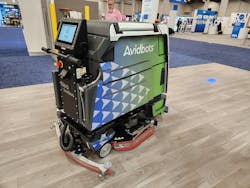Cleaning robots—which were out in force at the 2023 ISSA Show North America—can supplement your human cleaning staff. But are they the right solution for your facility?
Duncan McLennan, senior product manager for robot developer Avidbots, explained what building owners and facilities managers need to know about investing in cleaning robots as the company’s flagship robot, Neo, scrubbed the floor in the company’s ISSA booth. McLennan recommends considering these four things before you buy a cleaning robot.
1. How much does your environment change?
Many people believe that a particular space doesn’t change much, but even a little change is hard for robots to adapt to, McLennan said. “Robots struggle to do things that change on a regular basis,” McLennan explained. “A robot can do the same thing a million times in a row on a car assembly line with no problem, but to dynamically adapt to changing conditions is a big challenge.” Neo, a fully autonomous cleaning robot that scrubs hard floors, can adapt the way it drives and navigates based on changing environments.
2. What are your top staffing challenges?
The availability of labor is a problem seemingly everywhere, and that can be an argument for investing in a robot because it can step in when humans aren’t available. Robots can also step up the quality of cleaning in areas where, for example, it would be hard or impossible to station a person in a particular space around the clock to achieve a higher level of cleanliness.
“It’s common that we see customers saying, ‘I need to up the quality of my cleaning or clean more often because my facility demands it’ and basically want to supplement their existing team,” McLennan said. “They’ll bring in a robot to assist and do a better job.”
3. What do you need the robot to do?
“One robot can’t do everything,” McLennan said. “There are machines in all sorts of different formats and sizes, and matching the machine to the application is really important.”
Avidbots conducts detailed site visit assessments to determine whether it makes sense to deploy a robot at a particular location. It may be that your application requires a robot that can perform a certain function or clean in tight corners, for example.
4. How long has it been since I investigated potential solutions?
“I would encourage people to take a look at what’s out there today,” McLennan urged. “Maybe you tested a robot five years ago and had a bad experience, which I’m sure some people did. Five years in some things isn’t a very long time, but five years in robotics is like a million years. Things change really quickly, so stay on top of it. Keep your eyes and ears open.”
About the Author
Janelle Penny
Editor-in-Chief at BUILDINGS
Janelle Penny has been with BUILDINGS since 2010. She is a two-time FOLIO: Eddie award winner who aims to deliver practical, actionable content for building owners and facilities professionals.

